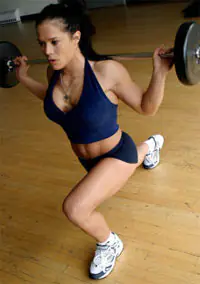Part No. 4
How to do lunges correctly? Execution technique.
The initial position is actually the same as for squats.
Take a step forward, for example with your left foot. The step must be taken slowly and under control. Remember: excessive haste leads directly to ligament injury. Your length step should be done so that your front foot (in our case the left) becomes knee bent at a right angle. And the back leg (in our example, the right one) too formed a right angle and practically touched the floor with her knee. By “almost touched” it is meant that resting your knee on the floor is under no circumstances possible, since the exercise will lose all meaning.
It is also very important for proper technique to hold exactly a right angle front leg, which actually performs lunge, since in the case of an acute angle, the knee ligaments are subject to excessive stretching, which is very fraught with a dangerous, difficult-to-heal injury. In the case of an obtuse angle in the knee, when the lunge is made too far, you simply will not be able to perform the exercise technically correctly. Your attention should be focused exclusively on the right angle in the knee joint.
We perform light rocking back and forth with the leg pointed forward, then return to the original position...
Now you understand how important precise technique and how to do lunges correctly. It is for this reason that it is extremely preferably At the preliminary stage, perform this exercise: either with a bare bar, or without weight at all. This is necessary for the correct selection of the optimal step length and an objective assessment of the position of the legs and the angles formed in the knee joints.
Another important point is the return to the starting position. It should be carried out only with the strength of the front (our left) leg. Push your foot off the floor, taking a step back. Control your balance - the bar should not overweight and lead you to any side.
Leg lunges can be varied in the following modes:
- constantly changing the leg, now approaching the left, then approaching the right;
- perform all sets on one leg, then all sets on the second;
- You can change legs in each repetition.
We recommend using the first two options because it is: more correct, safer and more reliable – it’s easier to maintain body balance throughout the entire approach.
Post Views: 91


